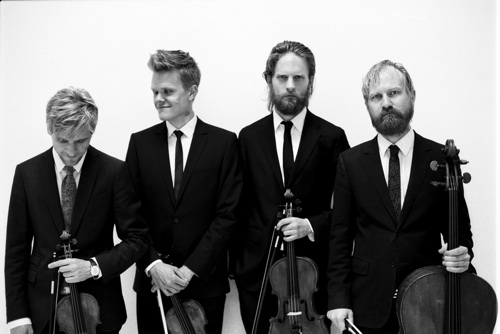Teaching taste and timelessness…
Cal Performances hosted the dynamic Danish String Quartet for a weeklong residency followed by a concert, held last Sunday at Hertz Hall on the UC campus. Their attentive reading of a modern work and edgy performance of two older works was a reminder of the timelessness of great art.
They warmed up with Joseph Haydn’s String Quartet in C Major, Op. 54, No. 2, an ingenious work from Haydn’s middle period. Using rounded leans instead of edged attacks, the four Danes conveyed a sunny unity, and even made it seem that one master instrument maker built their four instruments.
But there was still plenty of room for individuality in the gentle conversation. First violinist Rune Tonsgaard Sørensen was all whipcords and nervous energy, sweeping into sharp up-bows with flair, while the lower violin line was portrayed by Frederick Øland with certainty and civility, the glue that held the four together. Cellist Fredrik Schøyen Sjölin was stalwart, bearded and genial, while violist Asbjørn Nørgaard was a severe presence with huge resonance.
After generous chords and elegant gestures, the Adagio was startlingly fresh. Here, the three lower strings spelled out slow notes as Sørensen skated high with soft gypsy-like figures.

Then they moved forward two hundred plus years to the contemporary British composer, Thomas Adès. Now in his forties, he wrote Arcadiana in 1994 as a very young composer.
Violist Nørgaard tried to explain it. “The seven movements each have a different character. They are like seven little paintings of the Greek Gods. It starts in the morning, where the Gods are happy… the fourth movement is about Death, but it is the middle of a cycle, not the end. There is still the rest of a cycle, the leave-taking and then memories of life.”
Despite that explanation it felt like an early work – albeit a brilliant early work – with lots of thin harmonics and scratchy bowing and dense discords. Adès’ was at his best in the yearning sixth movement, an elegy with rich chords and simple themes and as stately as Elgar’s “Nimrod” (to which it refers).
After intermission came a masterpiece that is much performed, Beethoven’s 16th and final quartet. Violinist Frederick Øland added his insights, flavored with a Danish accent and stilted vocabulary.
“Here Beethoven is cutting up the themes into very little pieces and strewing them around, so it is a little fractured… The slow movement is very settled, very calm, an extremely beautiful slow movement.”
This performance was exceptional, a truly modern painting of the emotions on a canvas stretched across the entirety of life. Despite Beethoven’s ill health and his nephew’s suicide attempt, the quartet he wrote was surprisingly accepting and even joyous.
Earlier that evening I had to climb onto a roof, but spent some long minutes watching a sky full of clouds and colors. The Lento was like that. Here Beethoven’s writing is so close to what I imagine is the Writing of the World that it echoed that intolerable beauty, shafts of sun and somberness… and then the setting of the sun.
With a fierce dedication to the moment, heavily scrubbed strings and exaggerated pauses, the Danish String Quartet’s modern edge gave us entry into their own deep and fluent feelings.
Timeless.
They returned for an encore, introduced by Øland. “This is a wedding song from a little island in Denmark. The couple have to drink three shots of alcohol, to represent the three elements of marriage: the sweet, the sour and the bitter. This is the sour element.”
Here was a perfect crossover tune, a slow dance with solid rhythms, layered strings, and decorated melody. But sour in a marriage? I guess after sweet and fiery – mead and akvavit – everyone can use some beer with hops.
—Adam Broner
Photo of the Danish String Quartet, from left: violinists Rune Tonsgaard Sørensen and Frederick Øland, violist Asbjørn Nørgaard and cellist Fredrik Schøyen Sjölin; photo by Caroline Bittencourt.
